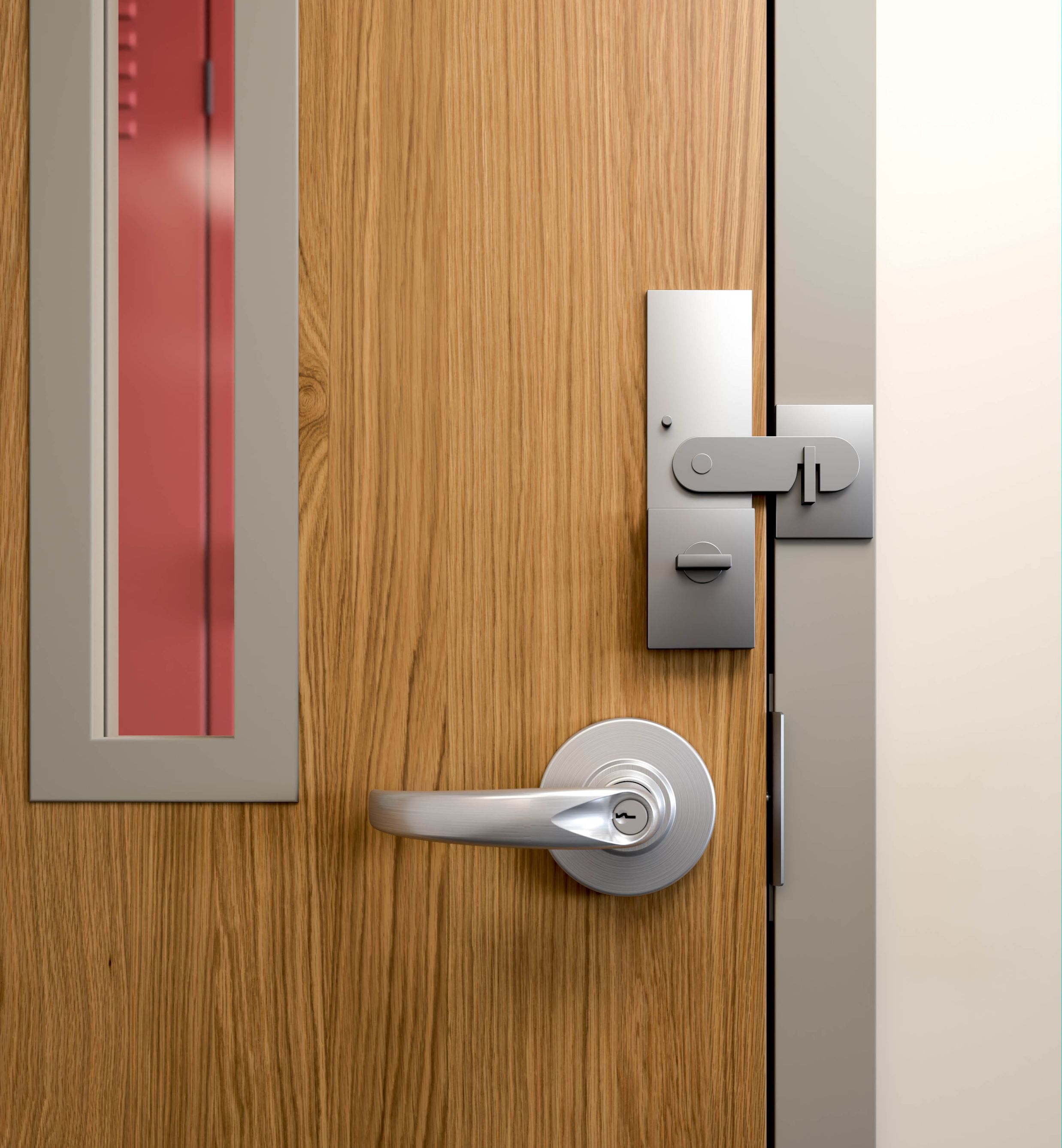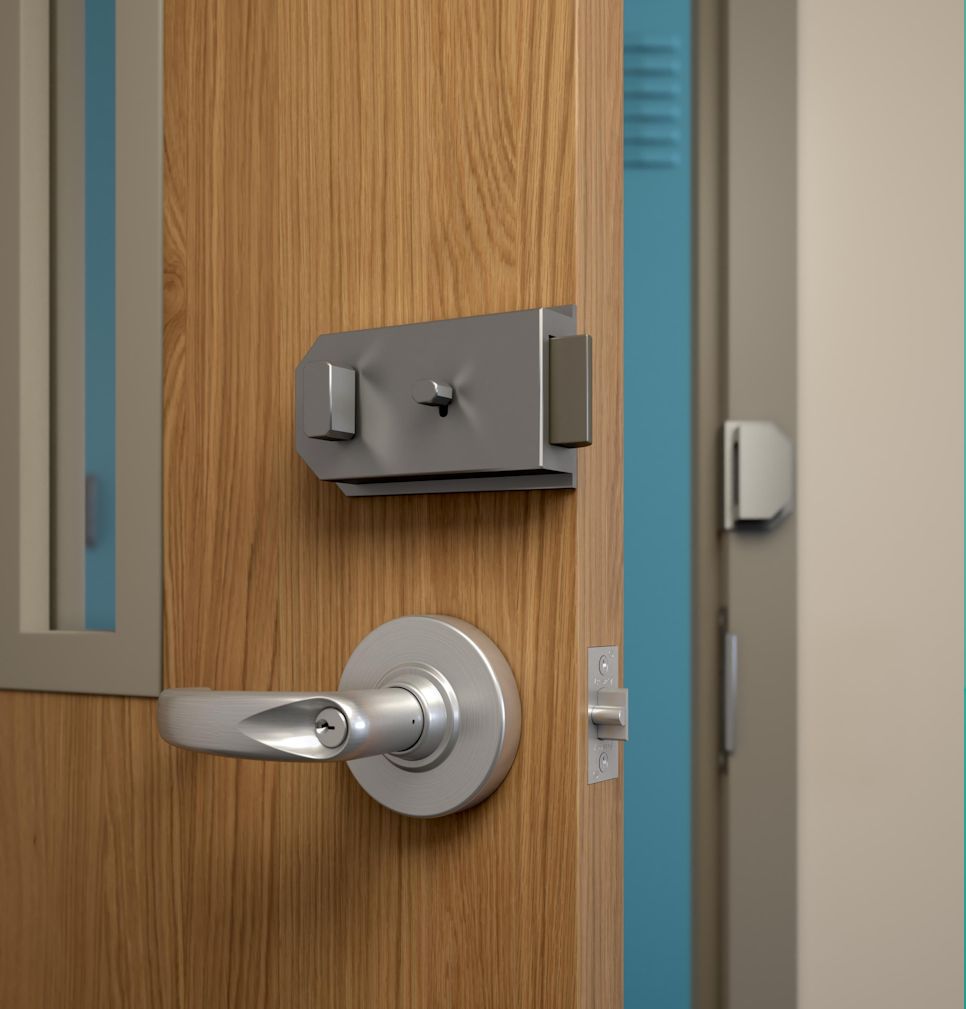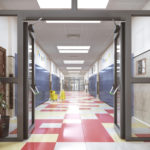This post was published in Door Security + Safety
.

In the last 5 years, the code requirements that apply to classroom security have been discussed and debated at length. An important part of the code development process is to gather information from all stakeholders, to ensure that the codes are based on the experience of many and that the issue is examined from all sides. Once a consensus is reached, a code change proposal is either approved and published in the next edition of the code, or it is disapproved and may be raised again during the next code development cycle.
In 2016, a proposal was made to change the 2018 edition of NFPA 101 – Life Safety Code regarding the allowable number of releasing operations for existing classroom doors in schools. The change would have allowed classroom doors in existing educational occupancies to have hardware that required two releasing operations instead of one. At NFPA’s annual meeting in June of 2017, voting members opted for a single operation to unlatch the door, and disapproved the two-operation proposal. Appeals were filed by a manufacturer of classroom barricade devices, but the appeals were denied by the NFPA Standards Council. The language allowing two releasing operations was not included in the 2018 edition of NFPA 101.
One operation, or two?

NFPA 101 requires locksets and security devices installed on classroom doors to meet all of the applicable criteria, and they must be acceptable to the AHJ.
For more than 30 years, the Life Safety Code has included a prescriptive requirement for hardware on most egress doors to unlatch with one operation. The exception is that residential dwelling units and sleeping units can have hardware that requires two releasing operations. Prior to the 1988 edition of NFPA 101, the code required a simple type of releasing device such as a knob, handle, or panic bar, with a method of operation that is obvious – even in the dark. As far back as the 1927 edition of the Building Exits Code, doors were required to be “so arranged as to be readily opened,” although the number of releasing operations was not specifically addressed.
It seems obvious that a door that requires one releasing operation would be more readily openable than a door that requires two or more releasing operations. A door with two locking devices could require “special knowledge or effort,” which is not compliant with the model codes. It’s likely that the two locks would need to be released or removed in a specific order, or there could be confusion about whether a lock is in the locked or unlocked position. The hardware on an egress door must be intuitive, or evacuation may be delayed.
During the 2018 code development cycle, there was strong support for code language that would continue to require one releasing operation to unlatch classroom doors. When the proposal for two releasing operations was discussed in 2016, the NFPA 101 Technical Committee on Means of Egress stated: “It is the position of the TC on Means of Egress that increasing the number of latch/lock releasing operations is dangerous and could create a hazard to occupants. Technology exists that will meet the current code requirement for not more than one latch/lock releasing operation. The need for multiple operations is contrary to decades of experience resulting in fatalities in schools and other buildings. Single-action egress is an important aspect of life safety for all emergencies.”
TIA 1436

TIA 1436 allows two operations to unlatch an existing classroom door, but the operations can not be simultaneous. The two latching devices shown in this photo are not compliant.
Given the committee’s position in 2016, the vote in 2017, the rejection of the appeals, and the fact that the 2018 edition of NFPA 101 requires no more than 1 releasing operation for egress, it seemed that the Life Safety Code would continue as it had for the previous 11 editions of the code. However, in 2019, a school district in Maryland submitted a TIA to revise the 2018 edition of NFPA 101. A TIA is a Tentative Interim Amendment – a change that may be proposed as a revision to an existing standard, to address a problem that is of an emergency nature. TIA 1436 proposed the addition of a line of text in the section addressing classroom doors in existing schools: “(3) Two non-simultaneous releasing operations shall be permitted.”
Despite opposition to the change and an appeal from the Builders Hardware Manufacturers Association (BHMA), as well as testimony from stakeholders including the Massachusetts State Fire Marshal on behalf of the National Association of State Fire Marshals (NASFM), the TIA was approved. Language allowing two non-simultaneous releasing operations on classroom doors in existing schools has been retroactively added to the 2018 edition of NFPA 101.
It might seem like this change was proposed in order to allow classroom barricade devices, but that was not the intent; the school district in Maryland wanted the ability to add deadbolts to their existing classroom doors. The substantiation for the proposed TIA specifically states, “Lacking the provision for two releasing operations on existing classroom doors, some schools are opting to purchase aftermarket barricade devices or utilize other ‘homemade’ solutions (e.g., sliding sections of fire hose over the door closer arm, rope, wedges, etc.), which restrict entry by a would-be assailant, but also restrict emergency egress and entry by school staff and emergency responders. Barricade devices can also be utilized by an assailant to contain occupants in a classroom and prevent assistance from entering.”
NFPA 101-2018 – Revised
The revised section in Chapter 15 – Existing Educational Occupancies allows classroom doors to be locked to prevent unwanted entry, if the locking means is acceptable to the authority having jurisdiction (AHJ), and meets the following conditions:
- The lock must be able to be engaged without opening the door, and must be able to be unlocked and unlatched from the classroom side without the use of a key, tool, special knowledge or effort. This also applies to locks that are remotely engaged.
- Two releasing operations shall be permitted to unlatch the door, but the two operations must not be required to be performed simultaneously. Two self-latching devices with latchbolts that must be retracted at the same time would not comply.
- The hardware releasing mechanism must be located between 34 inches and 48 inches above the finished floor. Security devices which mount at the bottom of the door or wrap the closer arm would not typically have their releasing hardware within the allowable range and would not be compliant with this section.
- The door must be able to be unlocked and opened from outside of the room with a key or other credential – like an access control card, code, or fob. Devices which barricade the door from the inside and cannot be removed by an authorized person from the outside do not meet this requirement.
- The door closer, panic hardware, or fire exit hardware shall not be modified by the security device. Retrofit security devices that attach to the existing door hardware could negatively impact the performance of the hardware and may void the product warranty.
- If the classroom door is a fire door assembly, all hardware must be listed to UL 10C and preparations for retrofit security devices must be acceptable per NFPA 80. Job-site preparations for hardware on fire door assemblies are typically limited to 1-inch-diameter holes unless the preparation is allowed by the listings of the door, frame, and hardware manufacturers, or approval for a field modification is obtained in advance from the listing laboratory.
- The means of engaging and releasing the lock from inside and outside of the room must be addressed in the facility’s emergency action plan and included in the emergency egress drills. This helps to ensure that staff is familiar with how to lock and unlock the classroom door when necessary.
Take Note
Applicability: The International Building Code (IBC) and International Fire Code (IFC) limit releasing operations for most egress doors to one operation to unlatch the door (all latches simultaneously). The extra releasing operation allowed by the TIA applies only to jurisdictions that have adopted the 2018 edition of NFPA 101 or have modified the applicable codes to allow a second releasing operation. Because the change was made in Chapter 15 of NFPA 101, the second operation is allowed only in existing K-12 schools. Classroom doors in new buildings are limited to one operation to unlatch the door by Chapter 14, and the chapters related to day care centers and college classrooms were not modified by the TIA.
Accessibility: The ADA Standards for Accessible Design require door hardware to be operable without tight grasping, pinching, or twisting of the wrist, so security devices on classroom doors must be operable in this manner in order to comply with federal law. Security devices that require two hands or a high level of dexterity to operate would not typically be considered compliant. The mounting height requirements of the ADA standards are consistent with the NFPA 101 requirements; devices should not be mounted above or below the allowable range of 34-48 inches above the floor.
Panic Hardware: Doors required to be equipped with panic hardware must unlatch with one releasing operation and shall not have any additional locking devices, per this section of NFPA 101: “7.2.1.5.12* Devices shall not be installed in connection with any door assembly on which panic hardware or fire exit hardware is required where such devices prevent or are intended to prevent the free use of the leaf for purposes of egress, unless otherwise provided in 7.2.1.6.”
Final Thoughts
There are many concerns associated with the use of retrofit security products, including delayed evacuation, unauthorized deployment, lack of access by emergency responders, and non-compliance with federal accessibility requirements. Although the TIA allows a second releasing operation to unlatch an existing classroom door, there are strict limitations in the Life Safety Code that must be met when choosing security devices.
Many deadbolts are compliant with the revised requirements of NFPA 101, but adding deadbolts to existing classroom doors may not be the optimal solution. School districts should carefully consider their options, as there may already be sufficient security in place, or the existing locks may be changed using code-compliant conversion kits. Links to the full TIA 1436 proposal, substantiation, and testimony, and other resources on school security can be found by visiting iDigHardware.com/schools.
You need to login or register to bookmark/favorite this content.






Had to read it a few times.
So how does this prohibit different types of barricade devices??
Hi Charles –
The locking devices would have to meet all of the other requirements of the section. For example, the releasing hardware must be between 34 and 48 inches above the floor, so devices that attach to the closer arm or project into the floor would not comply. There are a few barricade devices that meet all of the criteria, so those would be compliant if approved by the AHJ.
– Lori
You mention K-12 Classrooms. How does this change affect the use of separate indicator deadbolts for toilet room doors? Because of the single motion requirement, we’ve been using mortise locks that incorporate indicator deadbolts to satisfy the requirement.
Hi Andy –
Great question. I would keep using the mortise lock with the indicator because the IBC still requires a single operation to unlatch the door. The revised section of NFPA 101 that allows two releasing operations would only apply to existing schools, AND the section specifically refers to classroom doors:
Classroom Door Locking to Prevent Unwanted Entry. Classroom doors shall be permitted to be locked to prevent unwanted entry provided that the locking means is approved and all of the following conditions are met…
– Lori
Hi Lori,
Great Article!
Question?
In the NFPA Notification, it states under Option One, that an interconnected lock-mortise lock pictured – Can be used for new construction. “It can also be retrofitted on existing doors.” My question is this. Can a mortise latchset be compliant if replaced with a Mortise Deadbolt-as pictured – and contain simultaneous retraction functionality?
Hi Richard –
I think what you’re asking is whether you can remove an L9070, for example, and replace it with a mortise lock with an integral deadbolt? If that’s the question, the answer is yes. If the inside lever retracts both the deadbolt and latchbolt, then it is code-compliant for egress. If the door is a fire door, NFPA 80 allows the function holes for mortise locks to be prepped in the field, so that is not a problem. If I misunderstood the question, let me know. 🙂
– Lori